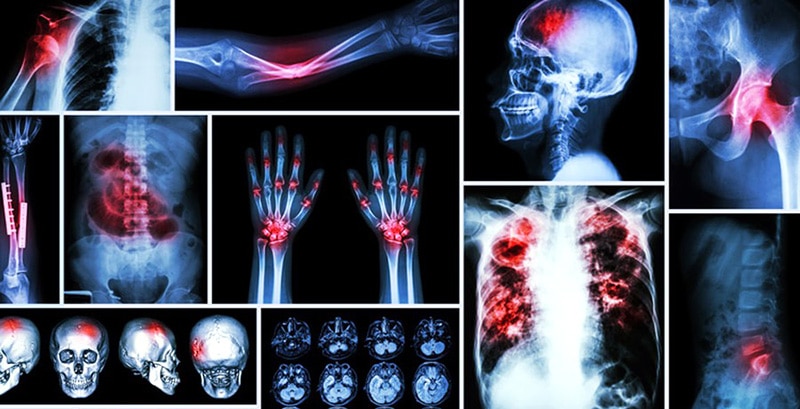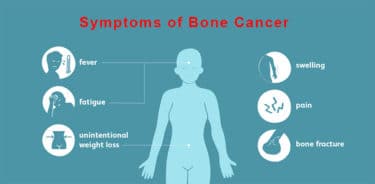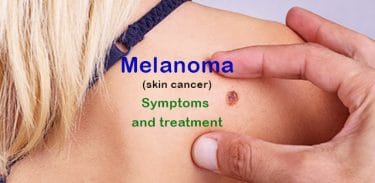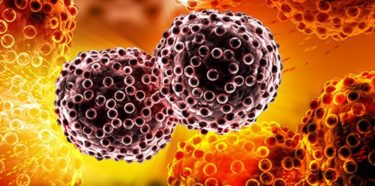Bone cancer is a rare type of cancer that spreads out in the skeletal system. Genetics, chronic bone disorders, and radiation therapy are the triggering factors. Among main symptoms are bone pain, swelling and lump in the affected area. It consists of four stages. If it is diagnosed in the first two stages, there is a high probability of recovery. The type and size of the tumor determine treatment options. Surgery is the most common treatment method where the organ with cancer is removed. Chemotherapy and radiotherapy can be required. It is mostly seen in children and the elderly. Bone cancer in adults develops as a result of the contagion of another cancer, and is assessed differently.
Table of Contents
What is bone cancer?
Bone cancer, begins when bone cells get abnormal and turn out to be the malignant tumors. It can emerge in any bone of body. But it often occurs in long bones such as arms, legs, and pelvis. It is a rare type of cancer (less than 1%). Men younger than twenty years old and the elderly are at higher risk. (1)
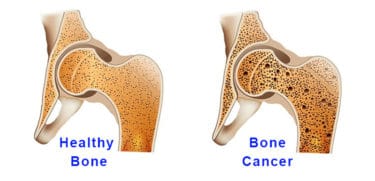
What causes bone cancer?
Although the exact cause of bone cancer is unknown, the main triggering factors include:
- Some rare genetic syndromes seen in the family history (such as hereditary retinoblastoma or Li-Fraumeni syndrome)
- Diseases such as Paget’s disease (excessive bone growth) seen especially in elderly
- Cancer treatments received in the past, such as radiotherapy, chemotherapy or bone marrow transplant
Symptoms of bone cancer
- Bone pain
- Red swelling, tenderness, and/or lump in the affected area
- Bone fracture (due to weakened bones)
- Fatigue
- Loss of appetite and unintentional weight loss
- Unexplained fever, tremors, and night sweats (rarely)
Bone cancer may not be noticed easly. Symptoms may vary depending on the location and size of tumor. Unusual pain is most typical symptom. Pain can be aggravated while using cancerous bone or at night. If it takes a long time and painkillers do not work, an orthopedic should be consulted. (2)
Types of bone cancer
Bone cancer is divided into different types according to the type of cells where the cancer begins. The main ones include:
Osteosarcoma
It is the most widespread bone cancer. It occurs in osteoblast cells that play a role in the formation and regeneration of bones. It usually appears in the knees and upper arms of children aged between 10 and 19 years old. It can develop in any bone of the body in the elderly. The tumor can replicate rapidly and metastasize to the lungs. It develops more often in men. (3)
Chondrosarcoma
Tumor begins in cartilage. It mostly develops in the shoulders, pelvis and upper legs and expands slowly. However, it can sometimes grow rapidly and spread to other parts of the body. In adults over the age of forty, the frequency of occurrence increases. Extraskeletal chondrosarcoma, a sub-category, begins in the tissues in the upper part of the arms and legs instead of cartilage. (4)
Ewing sarcoma
It originates commonly in the pelvis, ribs, or legs. It may rarely develop in soft tissues (such as muscles, fat, blood vessels). It is a rapidly replicating tumor and can spread to distant parts of the body, such as the lungs. It occurs more often in boys and teens under the age of 19. (5)
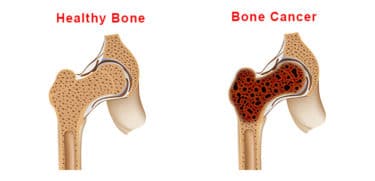
Chordoma
It is a rare type that originates in the spine and is mostly seen in the elderly. It usually develops at the base of the spine and skull. The risk is higher in women. It occurs at the base of the skull or the neck (cervical spine) in children and adolescents. (6)
Not all tumors developing in the bones are cancerous. Benign tumors can also develop in the bones and are usually not dangerous. They do not spread and damage bone tissues. However, if they are not intervened and treated early, they become cancerous over time.
Secondary (metastatic) bone cancer
It begins when another type of cancer spreads to the bones. It is more frequent in adults. It usually occurs as a result of breast cancer and prostate cancer. It is called, for example, breast cancer that metastasizes to the bone. It can cause hypercalcemia in the blood, causing bone fractures, pain, and abnormal calcium levels. (7)
Diagnosis of bone cancer
The steps to diagnose the bone cancer are usually as follows:
- Physical examination: The affected area is examined. If any, a swelling or a mass is checked. Questions are asked about the general health of the patient, cancer cases in the family, and how the pain develops.
- X-ray: Bone cancer can be clearly detected on x-ray films. It can even be determined whether the tumor is cancerous. However, a biopsy may still be required to verify the diagnosis.
- Biopsy: Carried out to diagnose whether the tumor is cancerous and determine its type. It also informs about the growth rate of cells. Usually, 2 different methods are used:
- Needle biopsy: A thin needle is inserted into the skin, and small pieces of tissues are removed by advancing it towards the tumor.
- Surgical biopsy: Some or all of the tumor is removed by an incision made in the skin under general anesthesia. This biopsy can also be applied during surgical intervention.
- Other tests: The imaging methods such as computed tomography (CT), magnetic resonance (MRI), bone scan, and Positron emission tomography (PET) help determine the stage of bone cancer and whether it metastasizes. An x-ray is also used to monitor the probability of bone cancer spreading into the lungs.
Stages of bone cancer
- Stage 1: Bone cancer is at an early stage.
- Stage 2: Cancer tumor is growing and likely to spread to surrounding tissues.
- Stage 3: Bone cancer has advanced to one or more areas of the bone and has begun to spread to the surrounding tissues.
- Stage 4: Cancer has spread to the surrounding tissues, organs such as lungs and brain.
Treatment of bone cancer
The type of cancer, its location, its stage, and the general health and the age of the patient determine which treatment method will be followed. Common treatment methods: (8)
Bone cancer surgery
This treatment method is the most common one. Depending on the state of the cancerous tumor, 2 different ways can be followed.
Limb-sparing surgery
It is selected when the cancer does not spread outside the bone. The surgeon removes the entire tumor in a way that there will be no cancer cells left on the edges of the tissue. Special surgical techniques can be performed to minimize the amount of healthy tissue removed together with the tumor.
A bone taken from anywhere in the body or a metal prosthesis is implanted to replace the removed bone. If the cancer is next to a joint like a knee, an artificial joint can replace the removed joint.
Amputation
Amputation may be necessary if cancer tumor is located at a complex point such as ankle or has spread outside the bone, such as major blood vessels or nerves. Limb with cancer can also be cut when a prosthesis or bone graft is removed due to an infection developed after limb-sparing surgery. It can be replaced by a prosthetic limb after the operated area heals. Today, the need for amputation has decreased as treatments options progress.
After both procedures, the rehabilitation process including physical therapy and psychological-occupational therapy begins.
Chemotherapy
Powerful anti-cancer medicines are given intravenously to destroy cancer cells. It is a crucial part of treatment in Ewing sarcoma and osteosarcoma. It is usually used to shrink the tumor and facilitate surgery. It can also be applied to prevent the recurrence of cancer after surgery or to reduce the effects of symptoms when treatment is not possible.
However, it is not used in all types of bone cancer, such as chondrosarcoma. Among the most common side effects of chemotherapy are nausea, vomiting, temporary hair loss and fatigue.
Radiation therapy
High-energy X-rays target at the affected area to destroy the tumor. Like chemotherapy, it is mostly applied before surgery. Since it can shrink the tumor, it may reduce the possibility of amputation. It can be applied together with chemotherapy in Ewing sarcoma. It can be given to destroy cancerous cells that remain in small quantities after surgery. It can also be performed for patients who cannot be operated.
The most common side effects are joint pain, skin redness, skin irritation in the area receiving radiotherapy and fatigue.
Targeted therapy
In this treatment, monoclonal antibody denosumab (Xgeva) medicine is given, which interacts with the molecule that causes cancer cells to replicate and spread. This special medicine can be applied to adolescents and adults, whose skeletal system is fully developed. It prevents osteoclasts, a type of blood cell, to destroy the bone tissue.
It can help shrink the giant cell bone tumor that cannot be removed surgically. It can also be used to shrink some tumors that come back after surgery. Common side effects include nausea, weakness and body aches.
Cryosurgery
To destroy the tumor in cryosurgery, the cancerous bone is removed surgically and frozen in liquid nitrogen. Usually, it can be performed in the first stage of bone cancer instead of surgical intervention, when the bone is not damaged much.
Is bone cancer fatal?
Earlier it is diagnosed, higher the chance of healing is. For example, the probability of a person with non-spreading chondrosarcoma to survive 5 years after diagnosis is 91%. However, if the cancer spreads to the lungs, this ratio may decrease to 33%. In this case, palliative care therapy can be used to relieve the symptoms of cancer.
Herbal remedies for bone cancer
Wheatgrass juice
This powerful antioxidant with high nutritional value does good for bone cancer. It can be easily prepared at home. Wheat seeds are moistened and kept in a place away from the sun. When the wheat sprouts, its juice is extracted by using special wheatgrass juicers. Drink one glass every day before breakfast. Wheatgrass powder can also be used by adding to water or yogurt.
Thistle
Effective against osteosarcoma, the most common type of bone cancer. It also has powerful antioxidants to reduce the side effects of radiotherapy. It can be used as a supplement. One cup of tea by brewing its seeds can be drunk per day.
Fenugreek seed
Strengthens bone tissues. Its tea can be drunk after brewed in a glass of boiled water.
Honey with cinnamon
Eaten on an empty stomach in the morning after adding one teaspoon of fresh cinnamon powder to one teaspoon of good quality honey. In addition, pollen, propolis and royal jelly can be beneficial.
Other herbs good for bone cancer include aloe vera, reishi mushroom, oats, yarrow, rosehip and green tea. All of them can be consumed as tea, or their dried forms can be added to yoghurt.
Do not use medicinal herbs and supplements without consulting your doctor.
Bone cancer diet
Bone cancer patients should consume plenty of high-protein and calorie foods in their daily meals. Especially these foods should be consumed:
- Dairy products such as homemade yogurt, kefir, and butter
- Chicken, fish and red meat
- Bone broth soups
- Legumes such as lentils, haricot beans
- Green leafy vegetables
- Citrus fruits such as tangerines, lemons and oranges (those who receive chemotherapy should not eat grapefruits)
- Turnip juice
Avoid all kinds of sweets, take-home and processed foods!
Suggestions for bone cancer patients
- Raise your awareness about your illness: Get detailed information about bone cancer and treatment options. Get a second opinion if necessary. Start treatment with a doctor you trust and follow his/her instructions.
- Get a psychological support: Most patients may be worried and frightened. Being involved with support groups and talking about other patients’ experiences can help you cope with your own illness. You can also go to a psychologist.
- Keep your close relationships strong: Do not isolate yourself from your social ties. Spend more time with people who make you feel good and who spiritually support you.
- Raise your spirits: Do activities that increase your energy and change your mood. Watch entertaining movies, read books that motivate you and spend time for your hobbies.
- Take lots of sunbathing: The natural source of vitamin D is the sun, which significantly reduces the replication of cancerous cells. Go out and take advantage of the sun as much as possible. Do simple exercises and breathing practices outside.

